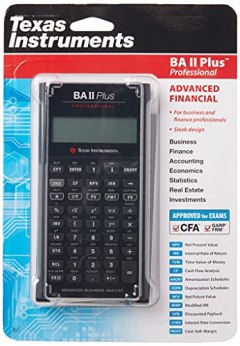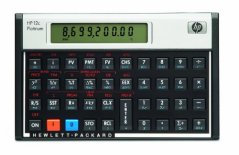BestReviews is reader-supported and may earn an affiliate commission. Details

We love the versatility built into this outstanding calculator, which makes fast work of the most complex computations.
There are an incredible 250 built-in functions and a two-line display that's easy to read with convenient menus and prompts. Able to perform the most difficult statistical and mathematical analyses. Clicking buttons are a cut above.
May be too much for some users in function and price.

This 12-digit solar-powered calculator was designed with finances in mind.
Loan Wizard helps you with business calculations. The 21mm LCD screen is clear and large enough to read at a distance. The selectable decimal placement makes currency calculation that much easier. Programmable keys give you some custom shortcuts.
Some want something with more features, while others praise the minimal approach.

This sleek calculator handles all sorts of complex equations; it's updated with a rugged metallic body for added durability.
This model excels at both basic math and advanced financial functions. Special "worksheet mode" allows users to perform complex calculations regarding depreciation, interest, amortization, and more. Large memory for previous calculations.
Some owners have reported that buttons can be unresponsive.

An updated classic with boosted capabilities and functions; a great choice for students and professionals.
Packed with more than 130 built-in functions, this calculator is highly versatile and allows users to customize it to their individual needs. Impressive memory retains hundreds of keystrokes. Compact and comes with a padded case.
One-line display isn’t as user-friendly as some models.

It's a classic calculator designed with professional number crunchers in mind.
The large LCD screen makes the numbers crystal clear. Backspace key allows for errors without starting over. Twin-power operation keeps it running longer. There are automatic tax keys for your convenience. Perfect for small business owners.
Some may want something with more expansive features.

We recommend these products based on an intensive research process that's designed to cut through the noise and find the top products in this space. Guided by experts, we spend hours looking into the factors that matter, to bring you these selections.

Whether you’re enrolling in a business class, taking a financial certification standardized test, or calculating payments on a loan, a financial calculator is a tool you’ll need.
A financial calculator can perform simple mathematical calculations like any handheld calculator. However, it can also calculate things like compound interest payments and rate conversions. It has extra keys to help you make these complex calculations quickly and efficiently.
If you’ve used a scientific calculator in the past, a financial calculator will look familiar to you. Both types of calculators are handheld devices that fit in the palm of your hand. They have small keys that are marked with the functions they provide. A monochrome display screen across the top shows both numbers and letters.
To find the best financial calculator for your situation, it helps to understand the various functions these units can perform. In this buying guide, we outline some of the key items to consider when shopping for a financial calculator.

Here are some high-level items to consider when shopping for a financial calculator.
For those who only need a calculator for an entry-level financial class or calculating simple loan terms, a basic financial calculator works nicely. These units often will offer time value of money (TVM) calculations. However, they often will not perform reverse Polish notation (RPN) calculations.
Finance professionals will need a high-end model capable of performing complex calculations. Certain financial classes also require a calculator with advanced functionality.
If you plan to use your financial calculator for an advanced college course or for a financial certification exam, only certain models will have the capability you require.
For example, with the CFP exam, you cannot use scientific graphing calculators. (These models often also can perform financial calculations.) Instead, you must use a financial calculator. However, the CFP exam rules don’t specify an exact model you must use.
For college courses or for certification exams like the CFA, you often must use a particular model of financial calculator. Always check with the entity administering the exam or with the course’s professor to figure out whether you need an exact model.
The following features help set the financial calculators on the market apart from each other so you can decide which fits your needs.
Powerful financial calculators carry a large number of built-in functions, perhaps 200 or more. But you will pay a higher price for this style of calculator. Even basic will carry at least 50 built-in functions.
The majority of financial calculators run on battery power — usually round, coin-style batteries. Some offer a solar power option, too, using the battery as a backup when light isn’t available. The ease of replacing a battery varies from model to model, as does battery life. The majority of calculator batteries last one to five years, depending on frequency of use.
The LCD screen on a financial calculator isn’t measured in size as it would be for, say, a smartphone screen. Instead, it’s measured in the number of characters and lines it can display at one time. Having dozens of characters visible simplifies the process of calculating complex equations.
Financial calculators have a bit of internal memory storage. This allows you to store data as you’re entering and using it. It also stores programming changes that you’ve made to the unit. A calculator with 12 to 20 kilobytes of memory is above average.
For those who need to perform financial calculations on the go, a calculator is a smart choice, as it fits in the palm of a hand. Some prefer a vertically aligned calculator; others prefer horizontally aligned units.
For financial planners who work in multiple currencies, having a financial calculator that can adjust to the current currency is important. This feature often is limited to expensive models.
Certain models of financial calculators are able to operate an alarm, remind you of appointments, and create reminder lists.
The least-expensive financial calculators cost between $20 and $40. These will do basic work very nicely, but they don’t usually have extra features, such as multi-line display screens or the ability to track appointments.
Pricier financial calculators run in the $40 to $70 range. These carry additional financial functions and extra memory compared to the less expensive models.
You could pay up to $100 for a financial calculator. Some of these higher-priced models have advanced scientific calculating and graphing functions. However, if you’re buying the calculator for a class or a test, there may be some limitations on the type of calculator you can use. Graphing calculators aren’t always allowed for standardized testing purposes.
Some people can get the functionality they need from a basic calculator or spreadsheet. Others will definitely need a financial calculator. Here are some reasons why you might the latter.

Q. How do I know if a particular key has an alternate function?
A. The key’s label should tell you if it has an alternate function. It will have one label across the top section of the key and a second label on the bottom, possibly in different colors. Just press the function key on the calculator to activate the secondary function of the next key you press.
Q. What are some inexpensive options for replacing batteries in a financial calculator?
A. Using cheap battery replacement options is not recommended. For safety, always refer to the instructions for your particular brand of calculator when choosing replacement batteries. Some models will restrict the use of rechargeable batteries, for example. Failure to follow the instructions and use approved batteries could lead to hardware damage.
Q. Why does my financial calculator display periods as digit separators instead of commas?
A. These calculators display digit separators for four-digit and larger numbers. Because both commas and periods are used around the world as a separator character, most calculators can display either one. You can usually toggle the display between these two characters using a key on your calculator.
Q. I need both a scientific and financial calculator. Can I find the features of both in one unit?
A. You can, but only to a degree. Financial calculators are not good for graphing, and they can not make complex scientific and mathematical calculations. A high-end scientific calculator can make some financial calculations, but it won’t be as easy to use as a financial calculator. For basic needs, one calculator for both functions will work fine. But for advanced needs, you’re probably better served by two different calculators.
Get emails you’ll love.
Learn about the products you’re wondering if you should buy and get advice on using your latest purchases.
